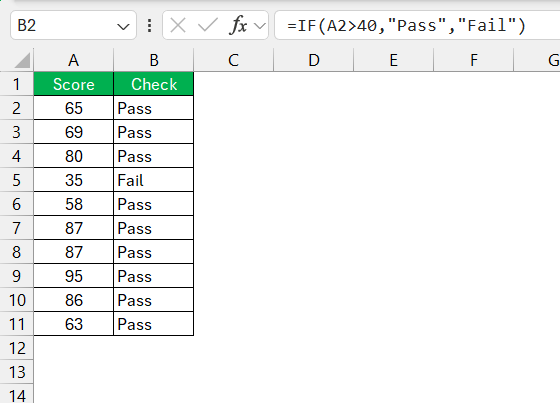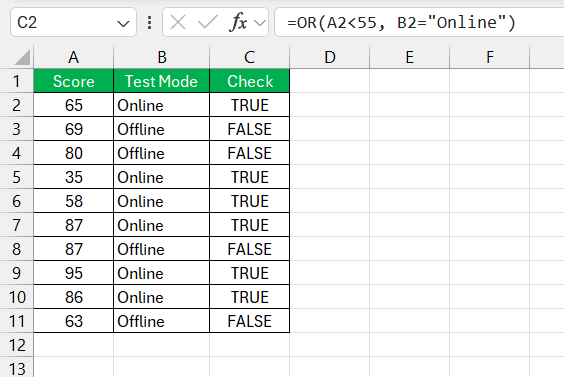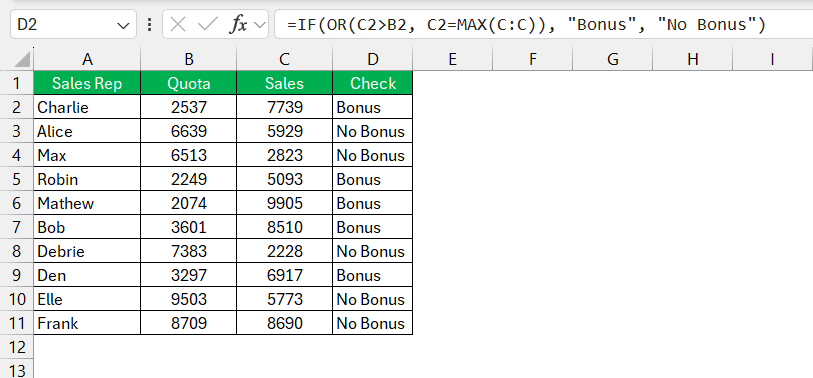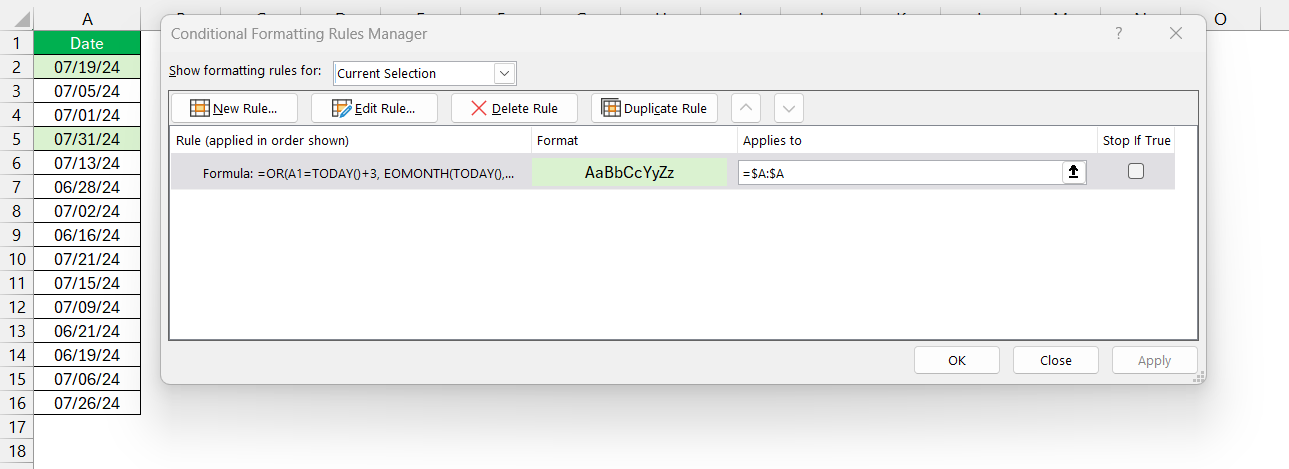Table of Contents
Introduction
Discover the Versatility of the OR Function Excel
If you’ve ever needed to make decisions based on multiple criteria, you know how impractical it can be to write out every possible scenario. That’s where the OR function in Microsoft Excel becomes your analytical sidekick. It shines by allowing you to compile various conditions into one formula, offering a flexible approach to data analysis.
Picture yourself checking a list and wanting a particular action if any item on your checklist is present; this is the essence of the OR function’s versatility.
Transforming Data Analysis with Smart Formulas
Smart formulas, packed with calculations, are like the secret sauce that turns your spreadsheets from mere data dumps into powerful, responsive tools that work for you. The OR function plays a critical role in this transformation, enabling you to create dynamic formulas that respond to diverse criteria.
This can revolutionize the way you approach tasks like data validation, risk assessment, and scenario analysis. It allows you to write leaner, more efficient formulas that adapt to the ever-changing landscape of your data, making your analysis work not just harder, but also smarter.
Understanding the OR Function
The Basic Syntax of OR in Excel
Diving into the core of Excel’s logical functions, the OR function stands out for its simplicity and power. The basic syntax is straightforward: =OR(logical1, [logical2], ...). This function will return TRUE if any of the conditions you specify (up to 255, in fact) are true.
You just need one condition to start, but the beauty of OR lies in its ability to juggle multiple at once. Think of it as your own digital decision tree, where any one of the branches can lead to a positive outcome.
How OR Affects Decision-Making in Formulas
When you bring OR into your formulas, you’re essentially instructing Excel to be less rigid and more accommodating in its decision-making process. Unlike a function that demands all conditions be met, OR only needs one of the criteria to be true to swing the decision in favor of action.
This flex in your formulas is reflected in decision-making scenarios like budgeting, where any expense over a certain amount may trigger a review, or in inventory management, where any stock below or above certain thresholds may warrant replenishment or promotion. OR widens your analytical lens, catching more opportunities and potential issues with a broader, more inclusive criterion.
Practical Applications
Simplifying Conditions with OR Function Examples
Imagine you’re sifting through a dataset of survey responses. You want to quickly identify participants who are either under 25 or prefer online shopping. With the OR function, this is a breeze.
By using =OR(A2<25, B2="Online"), Excel will return TRUE for any rows where either condition is met, simplifying your analysis significantly. It’s like having an assistant to do the initial sorting, letting you focus on the insights.
Integrating OR with Other Functions for Complex Criteria
The real magic happens when you start combining the OR function with others like IF, AND, and SUMIF to handle more nuanced criteria. Imagine needing to grant a bonus to sales reps who either exceeded their quota in the current month or have made the most sales overall.
You could craft a formula like =IF(OR(C2>B2, C2=MAX(C:C)), "Bonus", "No Bonus") that elegantly captures this complex logic.
This fusion of functions allows you to layer multiple conditions, creating intricate and powerful formulas that can handle almost any scenario you throw at them.
Advanced Techniques
Nesting OR within IF Statements
Nesting OR within IF statements is like unlocking a new level of formula flexibility. By doing this, Excel can handle complex, multifaceted logic that mimics real-life decision processes. For instance, if you need to categorize fruits and vegetables, a nested formula might look like =IF(OR(A2="apple", A2="orange"), "Fruit", IF(OR(A2="tomato", A2="cucumber"), "Vegetable", "")).
This effectively tells Excel: if the cell contains “apple” or “orange”, it’s a fruit; if it’s “tomato” or “cucumber”, it’s a vegetable; otherwise, leave the cell blank. Such precise logic within one formula streamlines your tasks remarkably.
Creative Uses of OR in Conditional Formatting
Conditional formatting with the OR function is like painting by numbers with a twist; you’re not just filling in based on one condition, you’re considering several. Let’s say you’ve got a list of deliverable dates and you want to highlight deadlines either at the end of the month or within the next three days. By setting a formula =OR(A2=TODAY()+3, EOMONTH(TODAY(),0)=A2), you can visually scan and pinpoint the critical dates immediately.
This creative use of OR injects life into your data, making it communicative and far more responsive to your needs.
Frequently Asked Questions
What Is the Difference Between the OR and XOR Functions?
The OR function will return TRUE if any of the conditions you set are true, and FALSE only if all conditions are false. In contrast, XOR stands for “exclusive or” – it’s a bit pickier. XOR returns TRUE only if an odd number of the conditions are true. If all or none are true, or if there’s an even number of true conditions, XOR says FALSE. It’s a subtle but important difference, especially when you’re dealing with logical operations that require precision.
Can You Combine AND, OR, and NOT Functions in a Single Formula?
Absolutely, you can blend AND, OR, and NOT functions within a single Excel formula to evaluate even the most complex logic. Picture a set of nesting dolls, with each function opening up to reveal another inside. For instance, you might use an AND function to require multiple conditions to be true, an OR function to allow for alternatives, and a NOT function to exclude specific scenarios. By chaining them together, you’re tailoring Excel’s logical processing to fit nuanced, real-world conditions.
How do you use or function in Excel?
To use the OR function in Excel, write =OR(condition1, condition2, …) in a cell, where each condition is a logical test that can either be TRUE or FALSE. Excel evaluates these conditions and if any one of them is TRUE, the OR function returns TRUE. Otherwise, it returns FALSE. It’s a versatile tool for scenarios where you’re interested in testing multiple possibilities.
How do you put 2 conditions in if Excel?
Putting two conditions in an IF statement in Excel is simple. You can use the AND or OR functions to combine these conditions. For AND, both conditions must be true: =IF(AND(condition1, condition2), value_if_true, value_if_false). For OR, only one of the conditions needs to be true: =IF(OR(condition1, condition2), value_if_true, value_if_false). This way, you control exactly how strict or lenient your IF logic needs to be.
What is the XOR function in Excel?
The XOR function in Excel is a logical function that stands for ‘Exclusive OR’. It specifically checks for an odd number of TRUE statements among the conditions you provide. If you write =XOR(condition1, condition2), it will return TRUE if exactly one of the conditions is TRUE—being exclusive, it doesn’t work with even numbers of TRUEs. It’s handy for situations where you need to enforce binary options or toggle-like scenarios in your data analysis.
John Michaloudis is a former accountant and finance analyst at General Electric, a Microsoft MVP since 2020, an Amazon #1 bestselling author of 4 Microsoft Excel books and teacher of Microsoft Excel & Office over at his flagship MyExcelOnline Academy Online Course.












